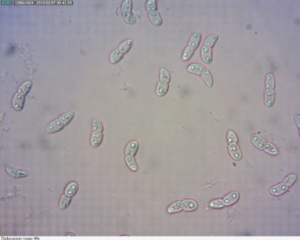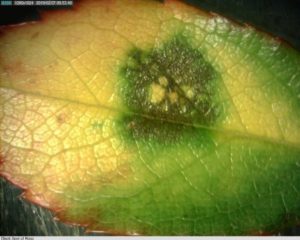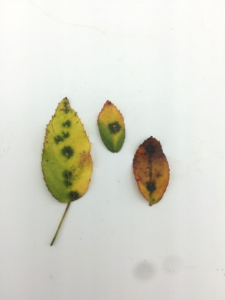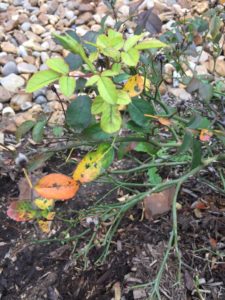Written by Christina Lanzoni — TPDDL Student Worker;
Edited by Hannah Ayala — Extension Assistant
Roses are red, leaves are green
Oh no they have spots, fungi are seen
Valentine’s Day is right around the corner and if you want to give your loved one some live roses, you might want to watch out for this pathogen.
One of the most important diseases that affects roses is Black Spot. Black Spot is caused by the fungus, Diplocarpon rosae. While this pathogen is virulent, it does not typically kill the plant; the disease will cause leaves to fall off and will weaken the plant making it more susceptible to other pathogens.
Diplocarpon rosae will overwinter in infected canes, buds, and leaves. When the growing season arrives, the new shoots that emerge can be infected with the overwintered fungus. Plants that do not contain the overwintered fungus can be infected when water, that contains spores, splashes on a new leaf or from airborne spores. In order for a plant to be infected, the spore must remain wet for at least 7 hours. Because of this, the ideal climate for D. rosae is one that is cooler and moist. High temperatures are found to limit the growth of the pathogen.
When plants are infected with D. rosae, characteristic circular spots with feathered margins form. Acervuli can often be found in the center of these spots. The tissue surrounding the spot will turn yellow and spread throughout the rest of the leaf. This chlorosis ends with the premature dropping of the leaf.
In order to prevent infection or spread of infection, the foliage should be kept dry. Try to water early in the morning so the foliage has time to dry and avoid overhead watering.w. Allow for good airflow by spacing plants and pruning when necessary. When diseased leaves are first found, remove and dispose of them. Infected leaves on the ground should also be removed and disposed of to prevent overwintering fungi causing further or future infection. A fungicide can be applied to prevent the spread of the infection, however,t will not cure infected leaves. Research the type of fungicide you can use to treat this disease and always make sure to follow the instructions.
So remember to properly water and prune your plants. You don’t want a Valentine’s Day without roses!
References:
Horst, R. K., & Cloyd, R. A. (n.d.). Compendium of Rose Diseases and Pests (2nd ed.). APS Press.
http://www.missouribotanicalgarden.org/gardens-gardening/your-garden/help-for-the-home-gardener/advice-tips-resources/pests-and-problems/diseases/fungal-spots/black-spot.aspx
Want to learn more?
Black Spot of Roses Factsheet
WHAT Wednesday: Black Spot of Roses







